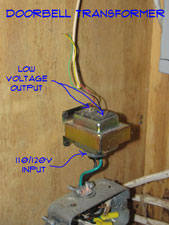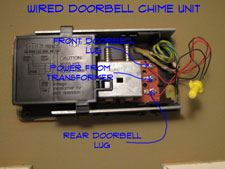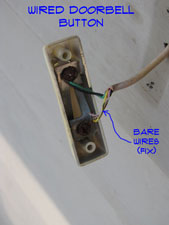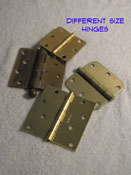Repair Topics
Wiring Doorbell Transformers
 Wiring doorbell transformers is not too difficult. Make sure the Power is OFF! before you work on it.
Wiring doorbell transformers is not too difficult. Make sure the Power is OFF! before you work on it.
Doorbell transformers need to provide the required voltage for the unit in question.The transformer reduces the 120 volt power in your home to the desired voltage for your doorbell. This is usually between 12 and 24 volts.
For related information, see the articles 'How To Fix a Wired Doorbell' ,'Wired Doorbell Buttons' and 'Wired Doorbell Installation'.
You will need to use a multi meter to tell if the transformer is working properly. Measure the voltage between the two terminals on the transformer.
Multi meters are a little tricky to use, take a look at, Using a Multimeter, for more information.
Does it match the secondary voltage that is needed. If not, you will need to replace the transformer. The 'secondary' or 'output' voltage should be marked on the transformer. It will be on an namplate, possibly embossed on the plastic shield where the low voltage wires are connected.
For the transformer listed in the picture the voltage should read 16 volts.
They are about ten to fifteen dollars. You can get them one from a home supply store. Obtain a new one with the same ratings as the one you have.
 Turn off the power and hook up the wiring the same as the old on. Use a voltage tester to make sure the power is off. One side of the transformer has the 120 volt wiring attached to it. This is the side that will shock you if the power is not off. Tag the wires if you need to.
Turn off the power and hook up the wiring the same as the old on. Use a voltage tester to make sure the power is off. One side of the transformer has the 120 volt wiring attached to it. This is the side that will shock you if the power is not off. Tag the wires if you need to.
The low voltage side will have two small wires attached to it. The polarity for these two wires does not matter. Remove both sets of wires from the transformer.
After you have removed the wires you can unscrew the transformer and install the new transformer and hook up the wires. The 120 volt wires go to the 'Line' side of the transformer and the low voltage wires connect to the 'Load' side.
Fixing Transformers
 Doorbell transformers need to provide voltage for the doorbell unit in question. You will need to use a multi meter to tell if the transformer is working properly.
Doorbell transformers need to provide voltage for the doorbell unit in question. You will need to use a multi meter to tell if the transformer is working properly.
There is not much you can fix on a doorbell transformer that is not converting the power correctly.
When this happens you will need to replace the transformer. They are about ten dollars. Obtain a new one with the same ratings as the one you have.
Turn off the power and hook up the wiring the same as the old one. Tag the wires if you need to.
For related information, see the articles 'How To Fix a Wired Doorbell' ,'Wired Doorbell Buttons' and 'Wired Doorbell Installation'.
Wired Doorbell Chimes
 Wired doorbell chimes are the part that makes the bell or chimes ring. There are a lot of different doorbell manufacturers with a lot of different models. The chime units themselves are architectural units and may be quite costly. So fixing them can be worth the effort
Wired doorbell chimes are the part that makes the bell or chimes ring. There are a lot of different doorbell manufacturers with a lot of different models. The chime units themselves are architectural units and may be quite costly. So fixing them can be worth the effort
You have a low voltage wire coming in from the transformer and additional wires coming in from one two or more doorbell buttons. The wired doorbell chimes ring differently for the different doors. One key thing is to check the connections for the low voltage doorbell wiring. An obvious loose or corroded wire should be fixed. The other big question would be, whether or not you are getting power from the transformer.
You can use voltage meter to check and see if you have power first to the chime unit from the transformer and then AC power to the transformer. Carefully use the leads on a multi meter or a voltage sensor to see if you have power. A low voltage sensor should be used at the chime unit and the outbound side of the transformer. A 120V AC sensor can be used at the inbound side of the transformer. Repair faulty wiring when you find it. Remember to turn the power off before messing with the wires.
Side Note: A note about testing circuitry. Meters and testers are other tools that you may need from time to time. For as little as twenty or thirty dollars you can arm yourself with a couple of voltage testers and a multi meter. I would suggest a standard voltage tester, a low voltage tester (non-contact testers are the best) and an inexpensive multi meter. Multi meters are a little tricky to use, try these resources for additional information, Using a Multimeter, for more information. With this testing equipment you will be able to trace down what is happening with electrical items in your home.
If you find that you have proper current and the buttons are in good order, then it is the chime unit. Time to go to the home improvement store and find another one. Pick out one you like and can afford. Follow the installation instructions. Presto, you now have a new doorbell and completed your doorbell wiring repair.
WARNING!! Make Sure the Power is OFF!!! BEFORE You Work on Electrical Devices!!!
Fixing Wired Doorbell Chimes
We are headed into uncharted waters here. Not really, but there are a lot of different doorbell manufacturers with a lot of different models. The chime units themselves are architectural units and my be quite costly. Simply put, you have a low voltage wire coming in from the transformer and additional wires coming in from one two or more doorbell buttons. The chimes ring differently for the different doors. One key thing is to check the connections for the low voltage wiring. An obvious loose or corroded wire should be fixed. The other big question would be, whether or not you are getting power from the transformer.
You can use voltage meter to check and see if you have power first to the chime unit from the transformer and then AC power to the transformer. Carefully use the leads on a multi meter or a voltage sensor to see if you have power. A low voltage sensor should be used at the chime unit and the outbound side of the transformer. A 120V AC sensor can be used at the inbound side of the transformer. Repair faulty wiring when you find it. Remember to turn the power off before messing with the wires.
Side Note: A note about testing circuitry. Meters and tester are other tools that you may need from time to time. For as little as twenty or thirty dollars you can arm yourself with a couple of voltage testers and a multi meter. I would suggest a standard voltage tester, a low voltage tester (non-contact testers are the best) and an inexpensive multi meter. Multi meters are a little tricky to use, try these resources for additional information, Using a Multimeter, for more information. With this testing equipment you will be able to trace down what is happening with electrical items in your home.
You can use voltage meter to check and see if you have power first to the chime unit from the transformer and then AC power to the transformer. Carefully use the leads on a multi meter or a voltage sensor to see if you have power. A low voltage sensor should be used at the chime unit and the outbound side of the transformer. A 120V AC sensor can be used at the inbound side of the transformer. Repair faulty wiring when you find it. Remember to turn the power off before messing with the wires.
If you find that you have proper current and the buttons are in good order, then it is the chime unit. Time to go to the home improvement store and find another one. Pick out one you like and can afford. Follow the installation instructions. Presto, you now have a new doorbell and completed your doorbell repair.
Wired Doorbell Buttons
 To repair wired doorbell buttons, remove the two screws on you doorbell button. There should be two wires attached to the back.
To repair wired doorbell buttons, remove the two screws on you doorbell button. There should be two wires attached to the back.
If you don't see wires, you have a wireless unit. See the article 'Wireless Doorbell Repair' for more information. Faulty wires or the button itself are the culprit most of the time. For related wired doorbell articles, see the article 'Fixing Wired Doorbells'.
Checking the Doorbell Wires
Are the wires loose or corroded? Yes, then turn off the power and clean them up or tighten them. Does the doorbell work now? Yes, great, your done fixing your wired doorbell button.
No, shut the power off and then unhook them from the button and see if the doorbell sounds when you touch the two wires together. Turn the power back on to do this. Does it work? Yes, then the button is bad and needs to be replaced. Obtain a new wired doorbell button and attach the two wires to it and screw it back onto the door jamb. Still not that hard, right?
Sticking Doorbell Buttons
Another issue with a wired doorbell button would be a doorbell that rings constantly. A sticking doorbell button is usually to blame. The button itself might need to be replaced. Turn the power off and unhook one of the wires from the button. Turn the power back on and see if it stops the ringing.
Yes, then it is the button. Get a new one and replace it. No, then it is a short in the wiring. Check the wires for cracks or missing insulation. Repair as needed.
Repairing Doorbell Buttons
Fixing a wired doorbell button will likely involve corroded and broken wires. On occasion the switch inside the doorbell button goes bad.
The first thing to do is remove the two screws on you wired doorbell button. There should be two wires attached to the back. Faulty wires or the button itself are the culprit most of the time. Are the wires loose or corroded? Yes, then turn off the power and clean them up or tighten them. Does the doorbell work now? Yes, great, your done with your doorbell repair.
If you don't see wires, you have a wireless doorbell unit. The article 'Fixing Wireless Doorbell Buttons' will give you some instructions on this issue.
No, shut the power off and then unhook them from the button and see if the doorbell sounds when you touch the two wires together. Turn the power back on to do this. Does it work? Yes, then the button is bad and needs to be replaced. Obtain a new wired doorbell button and attach the two wires to it and screw it back onto the door jamb. Still not that hard, right?
If this does not work then it is a short in the wiring. Check the wires for cracks or missing insulation. Repair the wires as needed. This will only work if the wires are visible. For broken or corroded wires that are hidden you will have to make a choice. Trying to fix or replace the wiring may be too big of a job to tackle. See the series of articles on 'Doorbell Wiring' for more information.
The other choice would be to replace the doorbell with a wireless doorbell. See the articles on 'Replacing Wireless Doorbells' for guidance.
Doorbell Wiring
 Wired Doorbells will, obviously, have doorbell wiring. All the components are connected by Wires. This type of system has a transformer that reduces the voltage down to something that the doorbell can handle
Wired Doorbells will, obviously, have doorbell wiring. All the components are connected by Wires. This type of system has a transformer that reduces the voltage down to something that the doorbell can handle
Not sure if this is your problem? See the articles 'Troubleshooting Doorbells', 'Repairing Wired Doorbells' and 'Fixing Wireless Doorbells' for listings on all the doorbell topics.
Doorbells have been around ever since 1831. In the early nineteen hundreds they became practical and common. Chimes and bells are a newer development, it used to be a buzzer, are you old enough to remember?. Today, we consider doorbells to be standard item in a home. Knocking is still an option, it's just that not everyone thinks to do it.
Most doorbells fall into two categories. Wired units consisting of a transformer, chime unit and the doorbells themselves. The other style is the wireless units that do not require internal hard wiring to operate. In this article we are focusing on wired units. See the article 'Doorbell Repair', for information on other types of doorbells.
Repairing Doorbell Wiring Using Common Sense
What Can You Save? - Assuming you had a simple problem it could run between $50 and $75 for an electrician to make a repair on your doorbell. You could be sold on a new system which might run $100 to $175 installed, even more for a high end system. Repairing it yourself might be as simple as tightening a loose wire. So your savings could be from $50 to $175.
How Hard Could It Be? - Doorbell wiring is fairly simple. Worst case scenario, replacing the entire system is not that hard. These repairs will have a Difficulty Level of: A Bit of Work. These repairs require a Skill Level of: Handyman. For and explanation of the terms in this section, see 'How to Use This Site'.
What Can Go Wrong? - Most of the components on a doorbell system are low voltage, therefore not dangerous. The exception is the transformer for a wired unit. Electrical shock rules apply, take precautions and shut the power off when working around the transformer. Yes serious injury and death are possible. Ruining a working unit trying to repair it is also possible. You can buy a whole new system for between $25 and $75, not the end of the world.
Troubleshooting Doorbell Wiring
The button is the culprit a lot of the time. See Step One for what to do. It is also the easiest thing. Next comes the chime unit. See Step Two for guidelines. Step Three talks about the transformer and what to do if it is bad.
The 'Wired Doorbell Buttons' are the first place to look when you start having trouble with your doorbell. This article provided tips on what to do.
The chime unit makes the doorbell sound that alerts you when the button is pushed. 'Wired Doorbell Chimes' can be fixed, but they require some special testers to check them.
The 'Doorbell Transformer' provides the power, reducing it from household current. These can be replaced for a reasonable sum.
Summary
A malfunctioning doorbell is not the end of the world. People got along for thousands of years just knocking. It is irritating when you don't know someone has visited because you didn't know the doorbell was not working.
Even if your doorbell repair involved replacing your equipment, it should not have been that hard. Now that you are done with your doorbell wiring you can decide what you want to do with all of your free time. Got more jobs on your list? Relaxing would be another viable option.
Door Hinge Sizes
 Door hinge sizes are an issue when purchasing new hinges. You will only want to do this if they need replacing.
Door hinge sizes are an issue when purchasing new hinges. You will only want to do this if they need replacing.
It is more likely that your door is out of adjustment, see 'Adjusting Interior Doors' or 'Adjusting Exterior Doors' for more information.
See 'Door Repair' for a complete listing of door topics.
The size and weight of the door will determine the size and number of hinges. Usually, you will replace the old ones with the same size and quantity.
A valid question. Most residential doors are between an 1 3/8" and 1 3/4" thick. So the normal size hinges for a residential door are 3" x 3" or 3 1/2" x 3 1/2". Your entrance doors might have 4" x 4" hinges, since the doors are heavier and usually thicker than the interior ones.
Measuring Door Hinge Sizes – You measure a door hinge when it is open and lying flat. The height is one dimension and the distance across both leaves is the other dimension. Butt door hinges are often the same size each way, but they don't have to be. It is possible to have hinges that are taller than they are wide. So it is a good idea to measure them both ways.
Is the hinge still on the door? Then you will have trouble getting a good measurement. You can also measure one side of the hinge from the edge of the hinge to the center of the pin. Take this dimension and double it to get the correct size.
Checking the Corners – There are more options, with different types of hinges, when it comes to the corners on the hinge. They might be square or they could have a radius. The square ones are easy, they are square. Both square and round corners are available with different door hinge sizes.
Radius corners are a more of a problem. They can be different radius's. The two common sizes for a radius on a door hinge is either 1/4" or 5/8". You should be able to use a tape measure to determine which size you have.
You may be wondering about the corners, why the difference? Rounded corners are made to fit into mortises that are cut with a router. Hinge jigs and commercial mortising machine use a round cutting head to cut out the mortise. So round corners are easier. They do have machinery that will cut square corners, but it involves another step.
Square corners are better when you are cutting the mortises with a chisel. Round corners are hard to do with a chisel. So there you have it, depending on the tooling you have, you may prefer, square or round corners. When replacing hinges, it makes things much easier to get the same size and style of hinge. Then you don't have to mess with the mortises at all.
So you have two things with the size that you need to make a note of. First the size of the hinges, height x width. Next the type and size of the corners on the hinge. When shopping for different types of hinges the best thing to do is take one of the old ones with you. Match them up at the store and you can't go wrong.
Purchasing Door Hinges
For a door hinge installation or replacement, you want hinges that are the same size and type as the one you have. The best practice is to take an old hinge with you when looking for replacements.
Even among hinges that are the same size, styles can vary. Spring loaded and ball bearing hinges are a couple of examples. See the article 'Types of Door Hinges', for an explanation of the various types and sizes of hinges.
Color and metal type are also important. A door with brass hardware, will likely have brass hinges. You may find stainless steel hinges that are the right size. It would be best to keep looking until you find the right metal finish.
Door hinges are measured by the dimensions when the hinge is open and lying flat. A 3 1/2" x 3 1/2" hinge will be 3 1/2" high, have a center pin and two plates that are approximately 1 1/2" wide. The common sizes for door residential door hinges are 3" and 3 1/2". They can come with both square and rounded corners. Most hardware stores and home supply stores will have a selection and stock the common sizes.
WARNING!! Doors Are Heavy, GET HELP When Removing a Door. Chisels Are Sharp, Use Caution!!! WARNING!!!
Summary
As you can see door hinges come in a number of sizes. See the articles, 'Adjusting Door Hinges', 'Replacing Door Hinges' and 'Squeaky Door Hinges' for related information.


